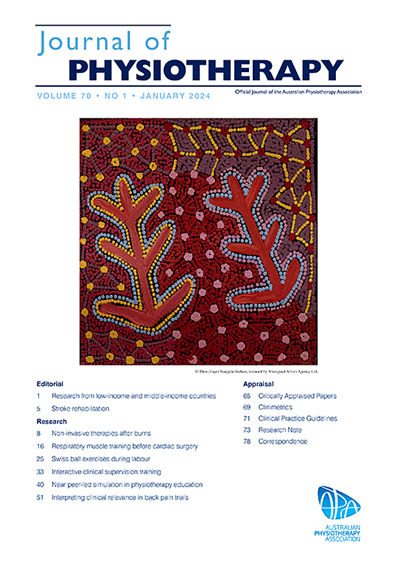在肩痛患者中,通过运动和锻炼进行动员比通过运动和锻炼进行假动员更能改善功能和疼痛:一项随机试验。
IF 9.7
1区 医学
Q1 ORTHOPEDICS
引用次数: 0
摘要
问题对于肩部疼痛患者,在标准锻炼计划中加入运动移动疗法(MWM)与假性运动移动疗法和相同的锻炼计划相比,对患者的功能和疼痛有何影响?随机试验,采用隐蔽分配、盲法结果评估和意向治疗分析:70名慢性肩袖外伤性疼痛患者,平均年龄48岁(SD 10):实验组接受肌肉萎缩疗法加锻炼,对照组接受假性肌肉萎缩疗法加锻炼。治疗每周两次,持续 5 周:主要结果测量指标为功能(0 至 100 肩痛与残疾指数)和疼痛(0 至 10 数字疼痛评分量表)。次要结果为自我效能、感知改善和主动无痛活动范围。评估时间点为基线(第 0 周)、治疗期结束(第 5 周)和治疗结束后 1 个月(第 9 周)的随访:结果:第 5 周时,实验组在功能(MD -15 分,95% CI -24 至 -7)、夜间疼痛(MD -2.1,95% CI -3.1 至 -1.1)、活动时疼痛(MD -1.5,95% CI -2.5 至 -0.6)和活动时疼痛(MD -1.5,95% CI -2.5 至 -0.6)方面的改善程度均高于对照组。6)以及屈曲(MD 16 度,95% CI 1 至 30)、外展(MD 23 度,95% CI 6 至 40)、外旋(MD 11 度,95% CI 4 至 17)和手背(MD 20 度,95% CI 8 至 32)的主动活动范围。第9周时,肩部疼痛和残疾指数(MD -9分,95% CI -17至-1)、夜间疼痛(MD -1.9,95% CI -2.9至-0.8)和运动时疼痛(MD -1.3,95% CI -2.3至-0.3)均有改善。由于置信区间较大,实验干预对其他结果的影响大多不明确。研究成功地进行了盲法:结论:在锻炼的基础上添加MWM可改善肩痛患者的功能、疼痛和活动范围。这些益处并非安慰剂效应:NCT04175184。本文章由计算机程序翻译,如有差异,请以英文原文为准。
In people with shoulder pain, mobilisation with movement and exercise improves function and pain more than sham mobilisation with movement and exercise: a randomised trial
Question
In people with shoulder pain, what is the effect of adding mobilisation with movement (MWM) to a standard exercise program on function and pain compared with sham MWM and the same exercise program?
Design
A randomised trial with concealed allocation, blinded outcome assessment and intention-to-treat analysis.
Participants
Seventy people with chronic atraumatic rotator cuff related pain, with a mean age 48 years (SD 10).
Interventions
The experimental group received MWM plus exercise and the control group received sham MWM plus exercise. Treatments were delivered twice per week for 5 weeks.
Outcome measures
The primary outcome measures were function (0 to 100 Shoulder Pain and Disability Index) and pain (0 to 10 Numerical Pain Rating Scale). Secondary outcomes were self-efficacy, perceived improvement and active pain-free range of movement. Assessment time points were at baseline (week 0), the end of the treatment period (week 5) and a follow-up 1 month after the end of treatment (week 9).
Results
At week 5, the experimental group improved more than the control group in function (MD –15 points, 95% CI –24 to –7), pain at night (MD –2.1, 95% CI –3.1 to –1.1), pain on movement (MD –1.5, 95% CI –2.5 to –0.6) and active range of movement in flexion (MD 16 deg, 95% CI 1 to 30), abduction (MD 23 deg, 95% CI 6 to 40), external rotation (MD 11 deg, 95% CI 4 to 17) and hand behind back (MD 20 deg, 95% CI 8 to 32). At week 9, benefits were seen in the Shoulder Pain and Disability Index (MD –9 points, 95% CI –17 to –1), pain at night (MD –1.9, 95% CI –2.9 to –0.8) and on movement (MD –1.3, 95% CI–2.3 to –0.3). The effects of the experimental intervention on other outcomes were mostly unclear due to wide confidence intervals. Blinding was successful.
Conclusions
Adding MWM to exercise improved function, pain and active range of movement in people with shoulder pain. These benefits were not placebo effects.
Registration
NCT04175184.
求助全文
通过发布文献求助,成功后即可免费获取论文全文。
去求助
来源期刊

Journal of Physiotherapy
ORTHOPEDICS-REHABILITATION
CiteScore
11.40
自引率
7.40%
发文量
69
审稿时长
72 days
期刊介绍:
The Journal of Physiotherapy is the official journal of the Australian Physiotherapy Association. It aims to publish high-quality research with a significant impact on global physiotherapy practice. The journal's vision is to lead the field in supporting clinicians to access, understand, and implement research evidence that will enhance person-centred care. In January 2008, the Journal of Physiotherapy became the first physiotherapy journal to adhere to the ICMJE requirement of registering randomized trials with a recognized Trial Registry. The journal prioritizes systematic reviews, clinical trials, economic analyses, experimental studies, qualitative studies, epidemiological studies, and observational studies. In January 2014, it also became the first core physiotherapy/physical therapy journal to provide free access to editorials and peer-reviewed original research. The Australian Physiotherapy Association extended their support for excellence in physiotherapy practice by sponsoring open access publication of all Journal of Physiotherapy content in 2016. As a result, all past, present, and future journal articles are freely accessible, and there are no author fees for publication.
 求助内容:
求助内容: 应助结果提醒方式:
应助结果提醒方式:


